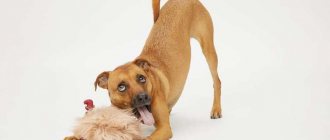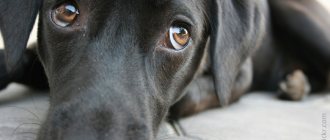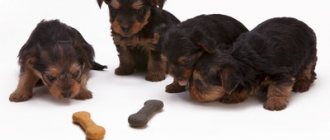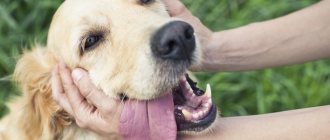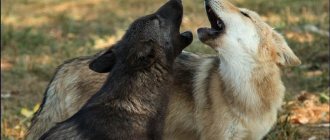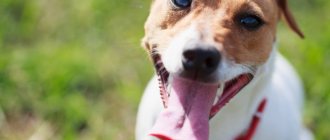Answer
If the pet exhibits characteristic signs - immobility, desire to lie down, decreased mood, lethargy, stiffness in movements - the cause is probably pain in the abdominal cavity.
Abdominal pain in an animal is difficult to recognize. There are characteristic signs that help to suspect pain that the pet is not able to report.
When there is pain in the abdominal organs, the animal tries to reach the stomach, arches its back in an uncharacteristic way, and changes its body position. The dog stretches out and begins to whine pitifully. During a walk, the animal stretches and muscle twitching is noted. She is not interested in anything, indifferent to what is happening. What is described becomes evidence of trouble in the digestive tract and difficulties in functioning.
Operations for discopathy
After receiving the data from the instrumental study, a decision is made on treatment methods.
In advanced stages of discopathy in dogs, surgery is suggested. As a rule, the disease is typical for animals in the second half of life, for which the risks of using anesthesia are themselves higher. Neurosurgical intervention and work on the spinal cord is a very delicate manipulation that not all veterinary surgeons are able to perform. Most often, surgical treatment can only be performed in specialized clinics in large cities. This, combined with the high cost of the operation, is often a decisive factor in choosing conservative treatment of discopathy in dogs at home. If it has not yielded results for a long time, and the owners are not ready to euthanize the animal on moral and ethical grounds, then it makes sense to decide on an operation.
The surgeon will remove part of the vertebral arch to provide direct access to the spinal cord. The deformed intervertebral disc is removed and, if necessary, the dura mater of the brain is opened. This helps reduce pressure on the spinal cord and improve metabolic processes and conductivity. There is a risk of formation of adhesions on the side of the hard shell. To do this, a hemostatic sponge is used during the operation, which covers the site where the destroyed disc was removed.
After the operation, physiotherapeutic and medicinal rehabilitation of the animal will be required. Moderate physical activity, proper massage and physiotherapy allow the dog to return to its normal lifestyle with some restrictions.
Successful surgery in animals that have retained deep sensitivity and functionality of the limbs has a 90% chance of complete recovery if treatment is started immediately after signs of the disease are detected. Relapses after removal of a damaged disc are extremely rare and are most often observed in dachshunds. In this case, a similar damage is established in another area.
How do abdominal pain manifest in dogs?
It is worth mentioning that tenderness in the pet's abdomen is recognized as a clinical sign of a serious illness or functional disorder. Pain itself can be a separate problem. The animal is not able to explain to the owner the peculiarities of its health; you should take a close look at the pet’s behavior. We will indicate a number of signs that should alert the owner:
- Decreased appetite, refusal of food and water, weight loss.
- Lethargy and apathetic behavior. The dog lies most of the time and refuses outdoor games and favorite toys.
- Depressed state and physical inactivity.
- Unreasonable fears of the animal - it tries to hide in the far corner and tries to hide.
- A sharp change in behavior - irritability, aggression, refusal to walk and play.
- Uncharacteristic movements and postures for an animal. The dog tries to arch its back, hunch over, raise its butt and lower its head.
- The temperature may rise.
- Normal heart rhythm is disrupted.
The color of the mucous membranes and the nature of the stool changes. The pet begins to vomit frequently and suffers from flatulence. An unpleasant odor emanates from the mouth.
The dog tries to pay attention to the abdominal cavity, but at the same time does not allow the owner to touch the stomach.
Characteristic clinical signs force the owner to contact a veterinarian. The specialist will conduct an examination and prescribe appropriate treatment.
Diagnostics
During a visual examination, the doctor must conduct clinical and neurological tests.
To do this, the specialist evaluates the remaining skills of walking, jumping up and down stairs. If they are present, the doctor assesses the speed of reflex activity. In the process, the animal is forced to transfer its body weight to one of the hind limbs, and then to the other, and withdraws its paw when pain occurs from external influences. These manipulations make it possible to diagnose discopathy in dogs based on symptoms and exclude diseases of the kidneys, gastrointestinal tract or reproductive function in females. They are similar in nature to destruction of the intervertebral disc. Decreased sensitivity in the limbs is characteristic of the symptoms of discopathy in dogs. In case of complete loss of functionality and conductivity, the time from the moment of their onset is assessed. After 12 hours of immobility, it is almost impossible to restore the conductivity of neurons, and, consequently, bowel movements. In this case, when diagnosing discopathy in dogs, a decision is made on the advisability of treatment and the question of euthanasia of the animal is raised. In case of refusal, maintenance therapy is selected for the rest of life.
As an instrumental diagnosis of spinal discopathy in dogs, owners have access to X-rays and MRIs.
. The image allows you to see changes in the distance between the vertebrae and rule out spinal injuries or diseases of the vertebrae themselves. A significant disadvantage of the method is the inability to see the condition of the disk and the extent of its damage. The advantage of the diagnostic method is its widespread availability and low cost.
The second most important method of instrumental research is myelography
. A contrast agent is injected into the dog's spinal cord under general anesthesia. By examining its spread, disk damage is assessed.
The most modern method is magnetic resonance imaging
. It is available only in large cities due to the high cost of the device. The animal undergoes an MRI under sedation. Diagnosis of discopathy is indicated in any condition, unless there is a contraindication to the administration of muscle relaxants. MRI shows an accurate and complete picture of the disease in dogs. Cross-sectional images are taken in small increments, which allows the neurologist to assess the overall picture.
Why does abdominal pain occur?
There are a number of known diseases that can cause abdominal pain. This can be mild food poisoning or a serious disease of the digestive system.
If an animal feels hungry, it can quickly swallow small objects, which leads to the development of severe pain in the stomach.
The following diseases are considered common causes:
- Intestinal parasitic diseases - helminthiasis or giardiasis.
- Intestinal obstruction, bloating and flatulence.
- Eating disorders.
- Infectious diseases and poisoning with poor quality food or toxic substances.
To determine the exact cause, the dog will be thoroughly examined by a veterinarian. A reliable diagnosis allows you to quickly and effectively treat your dog, relieve your pet of pain and restore health.
Diagnosis, treatment methods
In order for the doctor to make a diagnosis and prescribe adequate treatment, in addition to examining the animal and medical history, it will be necessary to conduct a number of diagnostic studies. Necessary diagnostic measures include general and biochemical blood tests, x-rays, ultrasound, MRI and CT.
There is no single treatment for a hunched back, as it is just a symptom of a disease. The principle of therapy is to eliminate the underlying disease diagnosed by the veterinarian. For example, for a herniated disc, painkillers, vitamin complexes, massage, laser therapy, and homeopathic remedies are used. In severe cases, surgical intervention becomes necessary.
For rheumatism, medications are given to relieve pain, inflammation, swelling, multivitamin complexes enriched with B vitamins, cardiovascular medications, and corticosteroids. If your pet has contraindications to taking medications, your veterinarian may recommend homeopathic ones.
For stomach cramps caused by helminthic infestation, the animal is advised to administer Arecoline solution, as well as Nemural, Tenifugin. When intestinal volvulus occurs, surgery is performed.
Under no circumstances should you self-medicate! If suspicious symptoms appear, take your pet to a specialist. Timely contacting a veterinary clinic significantly increases the chances of a favorable prognosis.
Why does discopathy occur in dogs?
Veterinarians say that the causes of the disease may be different.
For example:
- Problems with water-salt balance.
- Predisposition of certain breeds. Dachshunds are especially susceptible to this disease. Almost half of dachshunds have a similar disease to one degree or another throughout their lives.
- Excess weight.
- Age. Most often, the disease is recorded in pets from 3 to 8 years old, but this does not mean that a one-year-old dog cannot develop discopathy.
- Hair loss.
- Severe obesity.
Characteristics and description of osteochondrosis in dogs
The spinal column consists of vertebrae and intervertebral discs - cartilaginous layers that perform a shock-absorbing function. With osteochondrosis in the spine, dogs develop degenerative disorders associated with a lack of nutrients.
The discs gradually thicken and flatten, causing increased wear of the vertebrae. Any mechanical impact leads to serious injury. Subsequent complications, including partial or complete paralysis of the limbs, occur against the background of deteriorating blood supply.
Thinned cartilage breaks down into multiple fragments, causing acute pain during movement. This type of pathology is called dissecting. Without timely treatment, it develops into osteoarthritis. With it, degenerative changes are noted not only in the articular cartilage, but also in neighboring tissues.
Treatment without surgery
Mild pain and slight stiffness of movement observed during the initial stage of the disease allow drug treatment.
The complex of medications used alleviates the symptoms of discopathy and reduces inflammation. There are no drugs to completely eliminate intervertebral disc degeneration. Chondroprotectors and supplements for long-term use help slow down the rate of development of the disease, which is often an opportunity not to resort to surgical treatment. Typically your veterinarian will recommend complete rest. The animal can be taken for walks without being allowed to actively move. Treatment for discopathy in dogs at home includes corticosteroid hormones, an injectable form of B vitamins, and drugs that reduce inflammation. Non-steroidal anti-inflammatory drugs, for example, Rimadyl, provide a quick effect, but have a serious risk of developing stomach ulcers and their rapid perforation.
During the recovery period, physiotherapy is prescribed. Experts often differ in their opinions regarding painkillers. An animal that does not experience pain after the action of medications is able to carry out unwanted motor activity. At a time when a dog that has not undergone anesthesia will refuse to move and voluntarily remain calm.
The use of chondroprotectors for established intervertebral disc discopathy in dogs is mandatory and is carried out over a long period. Among the drugs, we can recommend Canina Flexan (Flexan). It contains bioactive collagen molecules that are essential for maintaining the structure of cartilage. Use in recommended doses significantly slows down intervertebral disc degeneration. The drug is compatible with any drug therapy and is recommended for both puppies and adult dogs.
Reduction of the inflammatory process is provided by the drug Canina Petvital Arthro tabletten. In the case of established discopathy, the remedy maintains the balance of substances in bone tissue and improves the elasticity of the ligaments, which take over the functions lost by the disc. B vitamins help improve the transmission of nerve impulses in the peripheral nervous system.
Canina Velox, consisting of mussels, has a positive effect on ligaments and discs. It contains chondroitin sulfate and hyaluronic acid. Drugs to maintain the intervertebral disc are given in long courses from 3, 4 months to lifelong use.
Forecasts for the future
It is important to note that complete cure does not occur even after surgery. Despite this, in most cases, veterinarians manage to restore motor function and maintain the animal’s quality of life.
The speed of recovery depends on the stage of the pathology and the method of treatment. With drug therapy, the rehabilitation period is about six months, and with surgical therapy – about 3 months.
The reason why the dog is lethargic, trembling and tucks its tail
There are several diseases that cause symptoms:
- Hypoglycemia.
- Toothache.
- Tumor in the head.
- Gene mutation.
What diseases can a tucked tail be a symptom of?
Hypoglycemia is a decrease in blood sugar levels. It happens in newly whelped bitches in the first days after giving birth. She becomes lethargic, almost does not eat, her gait is unsteady, her tail is tucked. Thermal metabolism is disrupted, the bitch trembles, whines, and worries. The owner urgently needs to call a veterinarian and provide first aid: drink sweet water, isolate from stress, cover with a blanket. Convulsions may begin.
A tucked tail indicates pain in the teeth, head or back. This is how the animal reacts to the fact that it cannot control its body. The true cause is determined after detailed studies.
New growths in the brain or spine cause a muscle reaction, paralysis or seizures, so the symptom is always paid attention to. Symptoms of oncology: loss of appetite, anxiety, weight loss, loss of coordination, insomnia, pain, aggression, lethargy.
When a puppy has a drooping tail
Gene mutations appear due to breed characteristics or improper breeding. They become obvious at a young age. Some spinal pathologies and hereditary diseases are incompatible with life. Outbred dogs do not suffer from this problem, because sick individuals do not produce viable offspring.
A drooping tail in puppies appears due to:
- fusion of the vertebrae in it, the organ breaks and becomes immobile;
- If mated too frequently, the bitch can produce weak offspring with defects.
In principle, such violations do not prevent the puppy from living a full life, but are considered defects of the breed. Such a baby will not be recognized at the exhibition. The appearance of a symptom of tail between legs in adults is a reason to worry and find out the cause: from a banal feeling of guilt and stress to serious diseases and genetic abnormalities.
Carrying out diagnostics
Before visiting the doctor, try to take a video of your pet while driving. In a clinical setting, many animals are too frightened to move further than the examination table, so your filming will help determine the nature of the lameness.
During the examination, the veterinarian carefully examines the condition of the bones and joints manually and using hardware. A biceps muscle test is required to check the reaction to stretching the paws. In the presence of fragments, such an action causes a sharp attack of pain, confirming the diagnosis.
The main diagnostic method for diseases of the musculoskeletal system is x-ray. The picture is taken in 2 projections at once (frontal and lateral) to examine in detail the condition of the bone, cartilage and articular tissues. This study is carried out strictly under anesthesia, since otherwise doctors cannot achieve a static position.
Additional diagnostic methods include the following:
- CT scan, used to obtain more detailed three-dimensional images;
- myelography, necessary to study the roots of the spinal cord;
- MRI, which reveals pathological changes between vertebrae using the resonance effect;
- arthroscopy, which determines damage to the inside of the joint by directly introducing a special device - an arthroscope.
Urine and blood tests or ultrasound and ECG results may also be required to make a diagnosis. They are necessary if infection and concomitant diseases are suspected as the root cause.
How to stop a dog from whining?
What to do if your pet regularly whines? If you can identify the causes, then your main goal will be to eliminate them. You can do the following:
- Does your pet lack affection and attention? Present it to him. But you shouldn't indulge your dog with hugs regularly. The situation will simply get worse. Your pet must understand that you care about him, love him, and devote a lot of time to him. Try to play more, communicate, walk outside with the dog, and be close to it more often.
- If the dog whines because he wants to go to the toilet, try to walk him on time so that the pet does not tolerate it.
- Show that whining is very bad. For example, take your pet into the next room or express your own dissatisfaction with a stern intonation. Do this more often so that the dog understands that he offends you with this behavior.
- If your dog constantly feels lonely and you often leave it at home, then try to accustom your pet to this. From the very beginning, only leave the room. But at the same time, show that you are not abandoning your pet, that you are near it. Then hide and do not react to your pet's barking. Over time, you can increase the period of the procedure.
- Never let your dog get bored. Introduce your pet to other dogs, walk with it, offer various entertainment, which will evoke only positive emotions in your pet.
- Has your dog recently encountered a stressful situation? Then surround him with your care, create ideal conditions for him so that he feels completely safe.
- Is your dog whining because he's sick? Take him to the vet so the situation doesn't get worse.
Why does he whine?
- Is the dog whining or begging for something? Then she must understand that she cannot get what she wants using this method. Try to comply with your pet's requests if he can be absolutely calm.
- From childhood, teach your pet not to show his own emotions so violently.
- Treat your animal and its health with special responsibility. Get regular vaccinations, take him to the veterinarian for examination, and monitor how your pet behaves.
- It is very useful to accustom your dog to a special regime. In this case, the pet will understand that it is necessary to go to bed, eat and walk outside only at certain hours. Consequently, the dog will stop demanding all this when he wants.
Physiological reasons
A feature of non-pathological factors is the rapid disappearance of symptoms after their elimination. If the dog is shaking without additional clinical manifestations, then the source of the problem may be stress, freezing, fear or nervous excitement. If the dog begins to shake after walking in the summer, then there is a risk of developing heat stroke.
Cold
Hypothermia is provoked by walking outside in the winter season, at low temperatures. The problem occurs in decorative and smooth-haired breeds, and is accompanied by involuntary tucking of the tail, paws, and slight trembling. The body tries to stabilize thermoregulation by constant muscle contraction.
At home, the pet does not react well to a sudden change in temperature after bathing: at the end of the water procedures, the dog should be thoroughly dried and, if possible, dried with a hairdryer. If the dog is afraid of noise, then a warm blanket or dry terry towel will come to the rescue.
Emotions: excitement, worry, fear
Trembling for no reason rarely occurs; more often the problem is associated with certain factors:
- a stressful situation - the dog hides after punishment or when anticipating an unpleasant educational process;
- fear – loud sounds, noise, the appearance of potential danger in the field of view;
- positive emotions - excitement before meeting the owner, in anticipation of a treat.
Attempts to attract attention are also accompanied by trembling. This feature is typical for breeds with docked tails - boxers, Rottweilers. In a dachshund puppy, the manifestation is associated with a psychological state, cunning.
Treatment of the disease
What methods are used to treat pets?
- If the clinical picture reveals only the presence of pain and discomfort, and the dog’s limbs do not lose sensitivity, then doctors prescribe treatment with non-steroids. For example, Rimadyl or ketofen.
- During drug treatment, the pet needs rest and limited mobility for up to a month. This technique is not suitable for dogs whose neck is affected. These pets have severe pain without loss of sensitivity in the limbs, but the discomfort begins again as soon as the effect of the medications stops.
- When a dog experiences very severe pain attacks accompanied by neurological symptoms, it needs to be operated on, removing the disc and stopping the compression of the spinal cord. The operation can be performed using the ventral slits technique, laminectomy, hemilaminectomy, etc.
- After surgery, the pet is recommended to take a course of antibacterial drugs.
- The recovery period includes massage, swimming, stimulation of the affected area with electric current, reflexology, etc. The recovery course is developed individually.
Reasons for the development of the disease
Unlike humans, osteochondrosis is more common in young dogs. This is due to the peculiarities of the development of their musculoskeletal system and connective tissue.
The causes of pathology include the following factors:
- trauma and inflammation;
- obesity;
- infections;
- gastrointestinal diseases that disrupt metabolism;
- cardiovascular diseases;
- poor environmental conditions;
- improper or poor quality nutrition (nutrient deficiencies and surpluses);
- excessive physical activity;
- autoimmune disorders and congenital anomalies characteristic of inbreeding;
- frequent hypothermia.
Approximately 80% of cases occur in male dogs. This means that the disease has a gender predisposition. It is also important to note the effect of too rapid growth of bone tissue, which is typical for animals with large dimensions.
What to do to stop trembling in a dog
Help depends on the source that caused the problem. With the physiological type, it is necessary to eliminate the influence of the causes:
- in winter, limit the time you walk or dress your pet in warm clothes;
- after bathing, dry the coat with a hairdryer;
- relieve the animal from stressful situations and strong experiences.
If an older dog's jaw shakes all the time or after eating, then the problem is related to age; there is no treatment for the anomaly. No external injuries or serious injuries require a visit to the veterinary clinic. After a diagnostic examination and diagnosis, the doctor will select a treatment regimen. Ignoring the symptoms of pathologies can cause diseases to progress to advanced forms and develop complications.
